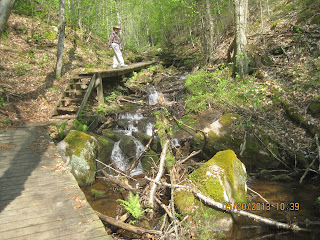This morning was overcast and 14C (57.2F). The forecast was
calling for “intermittent showers with the possibility of a thunderstorm” over
the next 3 days. However, by the time we did our rounds, checked in at the
office & came back for breakfast, the clouds had cleared out. There were a
few campers that have packed up and left already! There are about 100 due to
leave today.
I decide to do the ‘Bat
Lake
Tiny differences in history & structure of soils can
have big consequences for the forests that grow on them. At the beginning of
the trail, we walked through a uniform forest
of White Pine
We walked alongside a “babbling brook” which was very
pretty.
To our surprise, we encountered this large piece of ice,
which must have fallen from the rock above!
We passed through one of the largest and most impressive
stands of Eastern Hemlock to be found in the Parkway Corridor of Algonquin,
nicknamed “Cathedral Grove”. They are important havens for different kinds of
wildlife, ranging from two species of warblers that nest up in the canopy, to
deer that often find winter shelter beneath the snow-catching branches.
After leaving Cathedral Grove, we reached the lookout, which
afforded a wonderful view.
 Eventually, we arrived
Eventually, we arrived
Although the mention of an “acidified lake” conjures up
visions of a sinister and sterile wasteland, Bat
Lake Bat Lake Bat
Lake
All in all, it was an interesting hike, outlining how the
slight differences in soil can have far-reaching consequences for the forest. However,
we didn’t see any wildlife today.
After returning from the trail, we rested before doing the 2:00 rounds. This time it was fairly easy, with
almost 100 campers departed! The campground went from 123 occupied sites this
morning to 25 this afternoon.




No comments:
Post a Comment